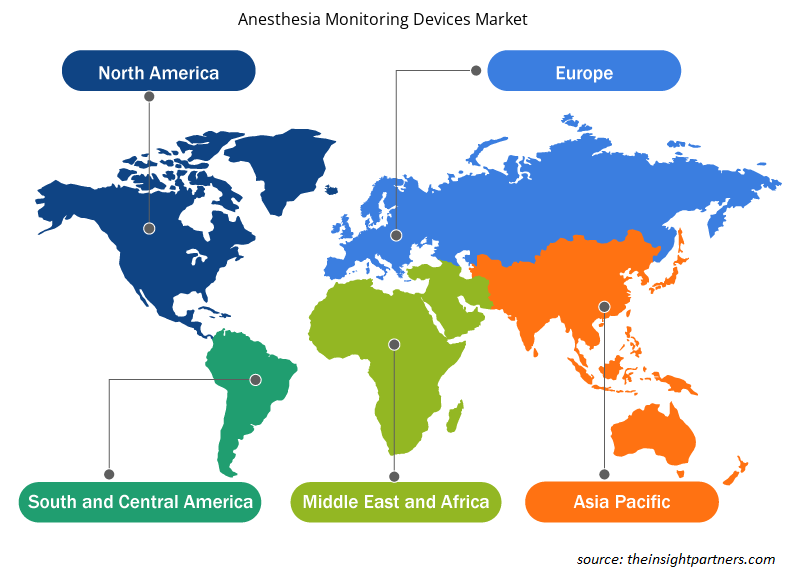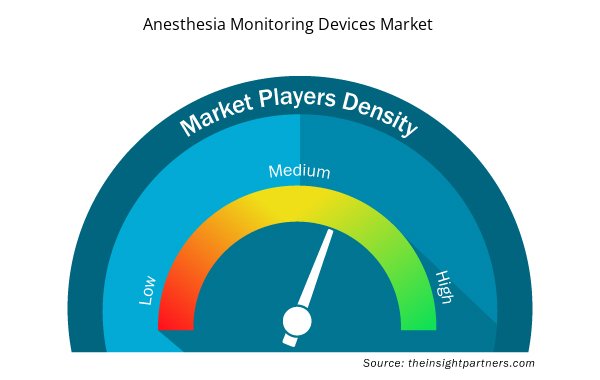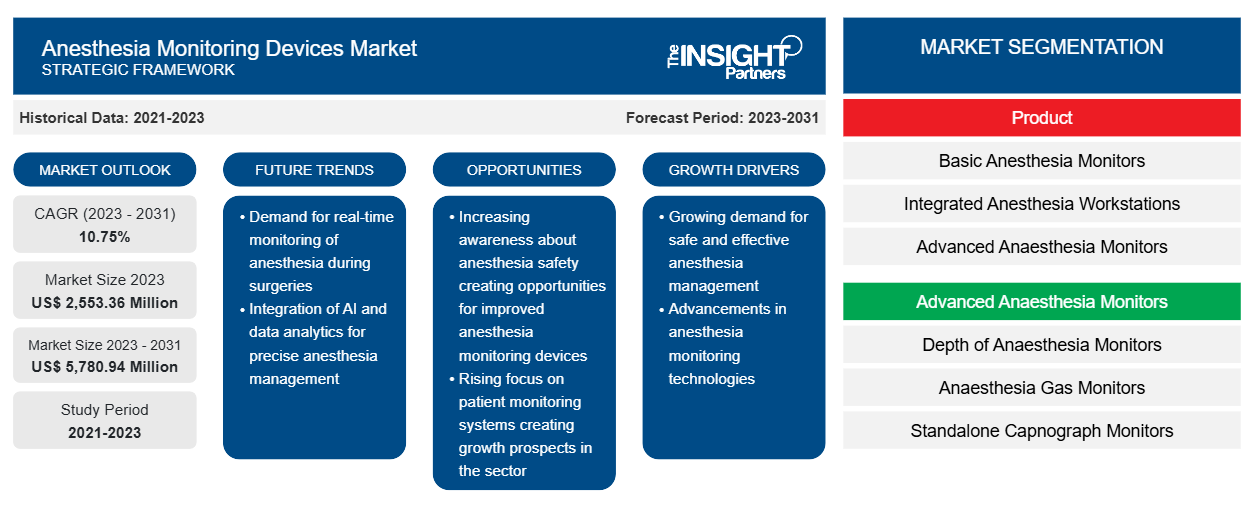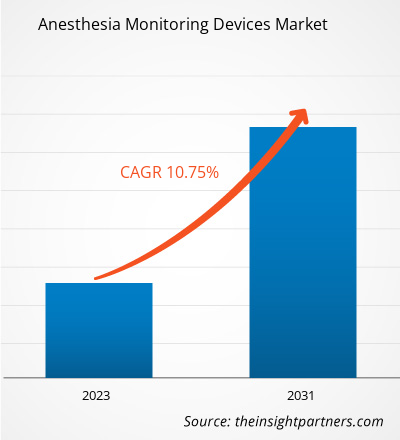[Rapporto di ricerca] Si prevede che il valore di mercato dei dispositivi di monitoraggio dell'anestesia crescerà da 2.553,36 milioni di dollari nel 2023 a 5.780,94 milioni di dollari entro il 2031; si prevede che il mercato registrerà un CAGR del 10,75% dal 2023 al 2031
Approfondimenti di mercato e opinioni degli analisti:
Durante gli interventi chirurgici, i dispositivi di monitoraggio dell'anestesia monitorano la reazione del paziente all'anestesia. Le misurazioni di ossigenazione, circolazione, respirazione e temperatura possono essere utilizzate per tracciare l'effetto dell'anestesia. La necessità di dispositivi di monitoraggio dell'anestesia varia da caso a caso e dipende dal tipo di intervento chirurgico eseguito. La somministrazione e il monitoraggio dell'anestesia durante le procedure chirurgiche sono un'abilità sofisticata che richiede molta formazione ed esperienza. I dispositivi di monitoraggio dell'anestesia assistono gli anestesisti nel monitoraggio del dosaggio dell'anestesia; inoltre, un buon monitoraggio del paziente riduce i rischi associati sia all'anestesia che all'intervento chirurgico.
I fattori chiave che guidano la crescita del mercato dei dispositivi di monitoraggio dell'anestesia sono l'introduzione di varie nuove tecniche di monitoraggio, come il monitoraggio della profondità dell'anestesia, la terapia dei fluidi mirata, il monitoraggio neurologico avanzato, il sistema di allarme migliorato e i progressi tecnologici nella valutazione oggettiva del dolore. Negli ultimi anni sono stati compiuti progressi significativi nello sviluppo della pratica clinica e nella tecnologia di monitoraggio clinico. Le tendenze dei dispositivi di monitoraggio dell'anestesia includono la rapida digitalizzazione dei dispositivi di monitoraggio dell'anestesia.
Fattori di crescita e sfide:
L'aumento del numero di interventi chirurgici sta guidando il mercato dei dispositivi di monitoraggio dell'anestesia
L'aumento del numero di interventi chirurgici influenza significativamente le dimensioni del mercato dei dispositivi di monitoraggio dell'anestesia, stimolando la domanda di tecnologie e soluzioni di monitoraggio avanzate. La Lancet Commission on Global Surgery (LCoGS) ha evidenziato che tra il 28% e il 32% del carico di malattie nel mondo richiede cure chirurgiche, gestione dell'anestesia o entrambe. Il rapporto "Global Surgery 2030 Evidence and Solutions for Achieving Health, Welfare, and Economic Development" indica che 5 miliardi di persone in tutto il mondo non hanno accesso a cure chirurgiche e anestetiche sicure e convenienti quando necessario. Si stima che 16,9 milioni di decessi siano attribuiti annualmente a implicazioni chirurgiche. Inoltre, l'NCBI segnala che ogni anno vengono eseguite 310 milioni di procedure chirurgiche, circa 20 milioni in Europa e 40-50 milioni negli Stati Uniti. I dispositivi di monitoraggio dell'anestesia garantiscono la sicurezza del paziente, ottimizzano la somministrazione dell'anestesia e monitorano i segni vitali durante le procedure chirurgiche. La crescente enfasi sui risultati per i pazienti, l'efficienza della gestione dell'anestesia e l'adozione di sofisticate apparecchiature di monitoraggio nelle sale operatorie sono fattori chiave che contribuiscono all'espansione del mercato.
D'altro canto, l'elevato costo associato ai dispositivi di monitoraggio dell'anestesia rappresenta una sfida significativa che può limitare la crescita del mercato e i tassi di adozione nel settore sanitario. L'investimento iniziale richiesto per l'acquisizione di dispositivi di monitoraggio avanzati e la formazione, la manutenzione e gli aggiornamenti aggiuntivi possono presentare barriere finanziarie per le strutture sanitarie, in particolare quelle che operano con budget limitati o limitazioni di risorse. Il costo sostanziale delle apparecchiature di monitoraggio dell'anestesia può gravare sulle spese in conto capitale, influire sulle considerazioni relative al ritorno sull'investimento e potenzialmente ritardare o scoraggiare gli operatori sanitari dall'investire in tecnologie di monitoraggio all'avanguardia. Inoltre, i costi operativi in corso, come le sostituzioni dei sensori, gli aggiornamenti software e i servizi di calibrazione, contribuiscono al costo totale di proprietà, influenzando le decisioni di acquisto e le valutazioni complessive del rapporto costo-efficacia per le istituzioni sanitarie. L'elevato costo dei dispositivi di monitoraggio dell'anestesia può anche mettere alla prova la penetrazione del mercato in regioni con infrastrutture sanitarie limitate, popolazioni sottoservite o disparità economiche, dove la convenienza e l'accessibilità delle tecnologie mediche avanzate rimangono considerazioni critiche.Pertanto, l'elevato costo associato a questi dispositivi di scansione ostacola la crescita del mercato dei dispositivi di monitoraggio dell'anestesia.
Personalizza questo report in base alle tue esigenze
Riceverai la personalizzazione gratuita di qualsiasi report, comprese parti di questo report, o analisi a livello nazionale, pacchetto dati Excel, oltre a usufruire di grandi offerte e sconti per start-up e università
- Scopri le principali tendenze di mercato in questo rapporto.Questo campione GRATUITO includerà analisi di dati che spaziano dalle tendenze di mercato alle stime e alle previsioni.
Segmentazione e ambito del report:
L'analisi del mercato dei dispositivi di monitoraggio dell'anestesia è stata effettuata considerando i seguenti segmenti:in base al prodotto, ai monitor avanzati per anestesia, alla tecnologia e all'utente finale. Geograficamente, il mercato dei dispositivi di monitoraggio dell'anestesia è segmentato in Nord America (Stati Uniti, Canada e Messico), Europa (Regno Unito, Germania, Francia, Italia, Spagna e resto d'Europa), Asia Pacifico (Cina, Giappone, India, Australia, Corea del Sud e resto dell'Asia Pacifico), Medio Oriente e Africa (Emirati Arabi Uniti, Arabia Saudita, Sud Africa e resto del Medio Oriente e dell'Africa) e Sud e Centro America (Brasile, Argentina e resto del Sud e Centro America).
Analisi segmentale:
Approfondimenti basati sui prodotti
In base al prodotto, il mercato è segmentato in monitor per anestesia di base, postazioni di lavoro per anestesia integrate e monitor per anestesia avanzati. Il segmento dei monitor per anestesia avanzati ha detenuto la quota di mercato più grande dei dispositivi di monitoraggio dell'anestesia nel 2023 e si prevede che registrerà il CAGR più elevato nel periodo 2023-2031.
Approfondimenti basati sul monitoraggio avanzato dell'anestesia
Sulla base dei monitor per anestesia avanzati, il mercato dei dispositivi di monitoraggio dell'anestesia è segmentato in monitor per anestesia di base, postazioni di lavoro per anestesia integrate e monitor per anestesia avanzati. Si prevede che la profondità del segmento dei monitor per anestesia avrà una quota significativa entro il 2031.
Approfondimenti basati sulla tecnologia
In base alla tecnologia, il mercato è classificato in indice bispettrale, potenziale evocato uditivo, indice di stato del paziente, indice di stato di attività corticale e altri. Si prevede che il segmento dell'indice bispettrale (BIS) avrà una quota significativa entro il 2031.
Informazioni basate sull'utente finale
In termini di utenti finali, il mercato è suddiviso in ospedali, cliniche specialistiche e centri chirurgici ambulatoriali. In termini di utenti finali, il segmento ospedaliero ha detenuto la quota di mercato più grande dei dispositivi di monitoraggio dell'anestesia nel 2023 e si prevede che registrerà il CAGR più elevato nel periodo 2023-2031.
Approfondimenti regionali sul mercato dei dispositivi di monitoraggio dell'anestesia
Le tendenze regionali e i fattori che influenzano il mercato dei dispositivi di monitoraggio dell'anestesia durante il periodo di previsione sono stati ampiamente spiegati dagli analisti di Insight Partners. Questa sezione discute anche i segmenti e la geografia del mercato dei dispositivi di monitoraggio dell'anestesia in Nord America, Europa, Asia Pacifico, Medio Oriente e Africa e America meridionale e centrale.

- Ottieni i dati specifici regionali per il mercato dei dispositivi di monitoraggio dell'anestesia
Ambito del rapporto di mercato sui dispositivi di monitoraggio dell'anestesia
| Attributo del report | Dettagli |
|---|---|
| Dimensioni del mercato nel 2023 | 2.553,36 milioni di dollari USA |
| Dimensioni del mercato entro il 2031 | 5.780,94 milioni di dollari USA |
| CAGR globale (2023-2031) | 10,75% |
| Dati storici | 2021-2023 |
| Periodo di previsione | 2023-2031 |
| Segmenti coperti | Per Prodotto
|
| Regioni e Paesi coperti | America del Nord
|
| Leader di mercato e profili aziendali chiave |
|
Dispositivi di monitoraggio dell'anestesia: densità degli attori del mercato: comprendere il suo impatto sulle dinamiche aziendali
Il mercato dei dispositivi di monitoraggio dell'anestesia sta crescendo rapidamente, spinto dalla crescente domanda degli utenti finali dovuta a fattori quali l'evoluzione delle preferenze dei consumatori, i progressi tecnologici e una maggiore consapevolezza dei benefici del prodotto. Con l'aumento della domanda, le aziende stanno ampliando le loro offerte, innovando per soddisfare le esigenze dei consumatori e capitalizzando sulle tendenze emergenti, il che alimenta ulteriormente la crescita del mercato.
La densità degli operatori di mercato si riferisce alla distribuzione di aziende o società che operano in un particolare mercato o settore. Indica quanti concorrenti (operatori di mercato) sono presenti in un dato spazio di mercato in relazione alle sue dimensioni o al valore di mercato totale.
Le principali aziende che operano nel mercato dei dispositivi di monitoraggio dell'anestesia sono:
- Mindray Medical International Limited
- Azienda Drägerwerk AG
- Assistenza sanitaria GE
- Koninklijke Philips NV
- Schiller AG
Disclaimer : le aziende elencate sopra non sono classificate secondo un ordine particolare.

- Ottieni una panoramica dei principali attori del mercato dei dispositivi di monitoraggio dell'anestesia
Analisi regionale:
L'ambito del rapporto di mercato sui dispositivi di monitoraggio dell'anestesia comprende Nord America, Europa, Asia Pacifico, Medio Oriente e Africa e Sud e Centro America. Il Nord America ha detenuto la quota maggiore del mercato dei dispositivi di monitoraggio dell'anestesia nel 2023 e si prevede che manterrà il suo predominio (in termini di quota) durante il periodo di previsione.Gli Stati Uniti detengono la quota di mercato più grande nel Nord America e nel mondo. La crescita del mercato in questo paese è attribuita all'aumento della prevalenza del cancro e all'aumento della popolazione geriatrica. Ad esempio, l'American Cancer Society ha affermato che nel 2021 sono stati segnalati circa 608.570 decessi correlati al cancro e sono state eseguite oltre 1,9 milioni di nuove diagnosi di cancro negli Stati Uniti. Inoltre, il crescente numero di procedure chirurgiche, i progressi tecnologici, la presenza di potenti attori del settore e una crescente attenzione alla sicurezza del paziente durante la somministrazione dell'anestesia sono tra i principali fattori previsti per incrementare il business complessivo. Altri fattori includono la crescente consapevolezza riguardo ai dispositivi di monitoraggio remoto dei pazienti per una migliore accuratezza, portabilità, connettività e interfacce intuitive.
Scenario competitivo e aziende chiave:
Le previsioni di mercato dei dispositivi di monitoraggio dell'anestesia presentate in questo rapporto possono aiutare gli stakeholder di questo mercato a pianificare le loro strategie di crescita. Mindray Medical International Limited; Drägerwerk AG; GE Healthcare; Koninklijke Philips NV; Schiller AG; Criticare Systems, Inc.; HEYER Medical AG; Infinium Medical, Inc.; Siare Engineering International Group Srl; e Nihon Kohden Corporation sono alcune delle aziende chiave descritte nel rapporto di mercato dei dispositivi di monitoraggio dell'anestesia. Queste aziende si concentrano sull'espansione delle loro offerte per soddisfare la crescente domanda dei consumatori in tutto il mondo. La loro presenza globale consente loro di servire molti clienti, consentendo loro di conseguenza di espandere la loro presenza sul mercato.
- Analisi storica (2 anni), anno base, previsione (7 anni) con CAGR
- Analisi PEST e SWOT
- Valore/volume delle dimensioni del mercato - Globale, regionale, nazionale
- Industria e panorama competitivo
- Set di dati Excel



Report Coverage
Revenue forecast, Company Analysis, Industry landscape, Growth factors, and Trends

Segment Covered
This text is related
to segments covered.

Regional Scope
North America, Europe, Asia Pacific, Middle East & Africa, South & Central America

Country Scope
This text is related
to country scope.
Domande frequenti
The key factors driving the anesthesia monitoring devices market growth are the introduction of various new monitoring techniques, such as monitoring the depth of anesthesia, goal-directed fluid therapy, advanced neurological monitoring, improved alarm system, and technological advancements in objective pain assessment. Significant progress has been made in clinical practice development and clinical monitoring technology in the last few years. Anesthesia monitoring devices trends include the rapid digitalization of anesthesia monitoring devices.
The anesthesia monitoring devices market was valued at US$ 2,553.36 million in 2023.
The anesthesia monitoring devices market is expected to be valued at US$ 5,780.94 million in 2031.
The anesthesia monitoring devices market has major market players, including Mindray Medical International Limited; Drägerwerk AG; GE Healthcare; Koninklijke Philips N.V.; Schiller AG; Criticare Systems, Inc.; HEYER Medical AG; Infinium Medical, Inc.; Siare Engineering International Group S.r.l.; and Nihon Kohden Corporation.
Based on product, the market is segmented into basic anesthesia monitors, integrated anesthesia workstations, and advanced anesthesia monitors. The advanced anaesthesia monitors segment held the largest anesthesia monitoring devices market share in 2023 and is anticipated to register the highest CAGR during 2023–2031.
Based on advanced anesthesia monitors, the anesthesia monitoring devices market is segmented into basic anesthesia monitors, integrated anesthesia workstations, and advanced anesthesia monitors. The depth of anaesthesia monitors segment is anticipated to hold a significant share by 2031..
During surgeries, anesthesia monitoring devices monitor the patient's reaction to anesthesia. Oxygenation, circulation, breathing, and temperature measurements can be used to track the effect of anesthesia. The need for anesthesia monitoring devices varies from case to case and is dependent on the kind of surgery being performed. Anesthesia administration and monitoring during surgical procedures is a sophisticated skill that requires much training and experience. Anesthesia monitoring devices assist anesthesiologists in monitoring anesthesia dosage; additionally, good patient monitoring lowers the risks associated with both anesthesia and surgery.
Trends and growth analysis reports related to Life Sciences : READ MORE..
The List of Companies - Anesthesia Monitoring Devices Market
- Mindray Medical International Limited
- Drägerwerk AG
- GE Healthcare
- Koninklijke Philips N.V.
- Schiller AG
- Criticare Systems, Inc.
- HEYER Medical AG
- Infinium Medical, Inc.
- Siare Engineering International Group S.r.l.
- Nihon Kohden Corporation
The Insight Partners performs research in 4 major stages: Data Collection & Secondary Research, Primary Research, Data Analysis and Data Triangulation & Final Review.
- Data Collection and Secondary Research:
As a market research and consulting firm operating from a decade, we have published and advised several client across the globe. First step for any study will start with an assessment of currently available data and insights from existing reports. Further, historical and current market information is collected from Investor Presentations, Annual Reports, SEC Filings, etc., and other information related to company’s performance and market positioning are gathered from Paid Databases (Factiva, Hoovers, and Reuters) and various other publications available in public domain.
Several associations trade associates, technical forums, institutes, societies and organization are accessed to gain technical as well as market related insights through their publications such as research papers, blogs and press releases related to the studies are referred to get cues about the market. Further, white papers, journals, magazines, and other news articles published in last 3 years are scrutinized and analyzed to understand the current market trends.
- Primary Research:
The primarily interview analysis comprise of data obtained from industry participants interview and answers to survey questions gathered by in-house primary team.
For primary research, interviews are conducted with industry experts/CEOs/Marketing Managers/VPs/Subject Matter Experts from both demand and supply side to get a 360-degree view of the market. The primary team conducts several interviews based on the complexity of the markets to understand the various market trends and dynamics which makes research more credible and precise.
A typical research interview fulfils the following functions:
- Provides first-hand information on the market size, market trends, growth trends, competitive landscape, and outlook
- Validates and strengthens in-house secondary research findings
- Develops the analysis team’s expertise and market understanding
Primary research involves email interactions and telephone interviews for each market, category, segment, and sub-segment across geographies. The participants who typically take part in such a process include, but are not limited to:
- Industry participants: VPs, business development managers, market intelligence managers and national sales managers
- Outside experts: Valuation experts, research analysts and key opinion leaders specializing in the electronics and semiconductor industry.
Below is the breakup of our primary respondents by company, designation, and region:

Once we receive the confirmation from primary research sources or primary respondents, we finalize the base year market estimation and forecast the data as per the macroeconomic and microeconomic factors assessed during data collection.
- Data Analysis:
Once data is validated through both secondary as well as primary respondents, we finalize the market estimations by hypothesis formulation and factor analysis at regional and country level.
- Macro-Economic Factor Analysis:
We analyse macroeconomic indicators such the gross domestic product (GDP), increase in the demand for goods and services across industries, technological advancement, regional economic growth, governmental policies, the influence of COVID-19, PEST analysis, and other aspects. This analysis aids in setting benchmarks for various nations/regions and approximating market splits. Additionally, the general trend of the aforementioned components aid in determining the market's development possibilities.
- Country Level Data:
Various factors that are especially aligned to the country are taken into account to determine the market size for a certain area and country, including the presence of vendors, such as headquarters and offices, the country's GDP, demand patterns, and industry growth. To comprehend the market dynamics for the nation, a number of growth variables, inhibitors, application areas, and current market trends are researched. The aforementioned elements aid in determining the country's overall market's growth potential.
- Company Profile:
The “Table of Contents” is formulated by listing and analyzing more than 25 - 30 companies operating in the market ecosystem across geographies. However, we profile only 10 companies as a standard practice in our syndicate reports. These 10 companies comprise leading, emerging, and regional players. Nonetheless, our analysis is not restricted to the 10 listed companies, we also analyze other companies present in the market to develop a holistic view and understand the prevailing trends. The “Company Profiles” section in the report covers key facts, business description, products & services, financial information, SWOT analysis, and key developments. The financial information presented is extracted from the annual reports and official documents of the publicly listed companies. Upon collecting the information for the sections of respective companies, we verify them via various primary sources and then compile the data in respective company profiles. The company level information helps us in deriving the base number as well as in forecasting the market size.
- Developing Base Number:
Aggregation of sales statistics (2020-2022) and macro-economic factor, and other secondary and primary research insights are utilized to arrive at base number and related market shares for 2022. The data gaps are identified in this step and relevant market data is analyzed, collected from paid primary interviews or databases. On finalizing the base year market size, forecasts are developed on the basis of macro-economic, industry and market growth factors and company level analysis.
- Data Triangulation and Final Review:
The market findings and base year market size calculations are validated from supply as well as demand side. Demand side validations are based on macro-economic factor analysis and benchmarks for respective regions and countries. In case of supply side validations, revenues of major companies are estimated (in case not available) based on industry benchmark, approximate number of employees, product portfolio, and primary interviews revenues are gathered. Further revenue from target product/service segment is assessed to avoid overshooting of market statistics. In case of heavy deviations between supply and demand side values, all thes steps are repeated to achieve synchronization.
We follow an iterative model, wherein we share our research findings with Subject Matter Experts (SME’s) and Key Opinion Leaders (KOLs) until consensus view of the market is not formulated – this model negates any drastic deviation in the opinions of experts. Only validated and universally acceptable research findings are quoted in our reports.
We have important check points that we use to validate our research findings – which we call – data triangulation, where we validate the information, we generate from secondary sources with primary interviews and then we re-validate with our internal data bases and Subject matter experts. This comprehensive model enables us to deliver high quality, reliable data in shortest possible time.


 Ottieni un campione gratuito per questo repot
Ottieni un campione gratuito per questo repot